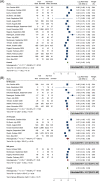Frailty and mortality associations in patients with COVID-19: a systematic review and meta-analysis
- PMID: 35066970
- PMCID: PMC9314619
- DOI: 10.1111/imj.15698
Frailty and mortality associations in patients with COVID-19: a systematic review and meta-analysis
Abstract
Background: Observational data during the pandemic have demonstrated mixed associations between frailty and mortality.
Aim: To examine associations between frailty and short-term mortality in patients hospitalised with coronavirus disease 2019 (COVID-19).
Methods: In this systematic review and meta-analysis, we searched PubMed, Embase and the COVID-19 living systematic review from 1 December 2019 to 15 July 2021. Studies reporting mortality and frailty scores in hospitalised patients with COVID-19 (age ≥18 years) were included. Data on patient demographics, short-term mortality (in hospital or within 30 days), intensive care unit (ICU) admission and need for invasive mechanical ventilation (IMV) were extracted. The quality of studies was assessed using the Newcastle-Ottawa Scale.
Results: Twenty-five studies reporting 34 628 patients were included. Overall, 26.2% (n = 9061) died. Patients who died were older (76.7 ± 9.6 vs 69.2 ± 13.4), more likely male (risk ratio (RR) = 1.08; 95% confidence interval (CI): 1.06-1.11) and had more comorbidities. Fifty-eight percent of patients were frail. Adjusting for age, there was no difference in short-term mortality between frail and non-frail patients (RR = 1.04; 95% CI: 0.84-1.28). The non-frail patients were commonly admitted to ICU (27.2% (4256/15639) vs 29.1% (3567/12274); P = 0.011) and had a higher mortality risk (RR = 1.63; 95% CI: 1.30-2.03) than frail patients. Among patients receiving IMV, there was no difference in mortality between frail and non-frail (RR = 1.62; 95% CI 0.93-2.77).
Conclusion: This systematic review did not demonstrate an independent association between frailty status and short-term mortality in patients with COVID-19. Patients with frailty were less commonly admitted to ICU and non-frail patients were more likely to receive IMV and had higher mortality risk. This finding may be related to allocation decisions for patients with frailty amidst the pandemic.
Keywords: COVID-19; frailty; hospital-related mortality; meta-analysis; older people; systematic review.
© 2022 Monash University, Peninsula Clinical School. Internal Medicine Journal published by John Wiley & Sons Australia, Ltd on behalf of Royal Australasian College of Physicians.
Figures



Similar articles
-
Association between Clinical Frailty Scale (CFS) and clinical presentation and outcomes in older inpatients with COVID-19.BMC Geriatr. 2023 Jan 2;23(1):1. doi: 10.1186/s12877-022-03642-y. BMC Geriatr. 2023. PMID: 36593448 Free PMC article.
-
Association between frailty and clinical outcomes in surgical patients admitted to intensive care units: a systematic review and meta-analysis.Br J Anaesth. 2022 Feb;128(2):258-271. doi: 10.1016/j.bja.2021.11.018. Epub 2021 Dec 17. Br J Anaesth. 2022. PMID: 34924178
-
Association between Clinical Frailty Scale score and hospital mortality in adult patients with COVID-19 (COMET): an international, multicentre, retrospective, observational cohort study.Lancet Healthy Longev. 2021 Mar;2(3):e163-e170. doi: 10.1016/S2666-7568(21)00006-4. Epub 2021 Feb 9. Lancet Healthy Longev. 2021. PMID: 33655235 Free PMC article.
-
Timely goals of care documentation in patients with frailty in the COVID-19 era: a retrospective multi-site study.Intern Med J. 2022 Jun;52(6):935-943. doi: 10.1111/imj.15671. Epub 2022 May 31. Intern Med J. 2022. PMID: 34935268
-
Frailty as a predictor of adverse outcomes in hospitalized older adults: A systematic review and meta-analysis.Ageing Res Rev. 2019 Dec;56:100960. doi: 10.1016/j.arr.2019.100960. Epub 2019 Sep 10. Ageing Res Rev. 2019. PMID: 31518686
Cited by
-
Association between a Frailty Index from Common Laboratory Values and Vital Signs (FI-LAB) and Hospital and Post-Hospital Outcomes in Veterans with COVID-19 Infection.J Nutr Health Aging. 2023;27(2):89-95. doi: 10.1007/s12603-023-1886-0. J Nutr Health Aging. 2023. PMID: 36806863 Free PMC article.
-
Limited incremental predictive value of the frailty index and other vulnerability measures from routine care data for mortality risk prediction in older patients with COVID-19 in primary care.BMC Prim Care. 2024 Feb 23;25(1):70. doi: 10.1186/s12875-024-02308-5. BMC Prim Care. 2024. PMID: 38395766 Free PMC article.
-
Impact of frailty on clinical outcomes in patients with and without COVID-19 pneumonitis admitted to intensive care units in Australia and New Zealand: a retrospective registry data analysis.Crit Care. 2022 Oct 3;26(1):301. doi: 10.1186/s13054-022-04177-9. Crit Care. 2022. PMID: 36192763 Free PMC article.
-
Association between Clinical Frailty Scale (CFS) and clinical presentation and outcomes in older inpatients with COVID-19.BMC Geriatr. 2023 Jan 2;23(1):1. doi: 10.1186/s12877-022-03642-y. BMC Geriatr. 2023. PMID: 36593448 Free PMC article.
-
To Be Frail or Not to Be Frail: This Is the Question-A Critical Narrative Review of Frailty.J Clin Med. 2024 Jan 26;13(3):721. doi: 10.3390/jcm13030721. J Clin Med. 2024. PMID: 38337415 Free PMC article. Review.
References
Publication types
MeSH terms
LinkOut - more resources
Full Text Sources
Medical

